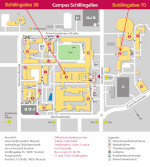AG Patenge
Contact
Dr. rer. nat. Nadja Patenge
location
Anfahrt zum IMIKRO

Main Topics
Small non-coding regulatory RNAs in Streptococcus pyogenes
S. pyogenes is a strictly human pathogen. It is responsible for a variety of human diseases, ranging from mild superficial infections (pharyngitis, impetigus) to invasive, life-threatening diseases (necrotizing fasciitis, streptococcal toxic shock syndrome). S. pyogenes is able to colonize different body surfaces in the human host and distinct strains exhibit considerable differences in virulence. The required adaption to the conditions at various host sites is achieved by a tightly controlled expression of streptococcal virulence factor genes. Beside protein-mediated transcriptional regulation of gene expression, bacteria use small regulatory RNAs (sRNAs) to modulate gene expression through sRNA-mRNA or sRNA-protein interaction.
In previous studies, we screened the genome of S. pyogenes for sRNA genes using bioinformatics approaches and gene-expression analyses, identifying more than fifty potential sRNA candidate genes (Patenge et al., 2012). Now, we are interested in the regulatory mechanisms of the individual sRNAs and in the role of these molecules in streptococcal virulence. MarS has been discovered recently in S. pyogenes by tiling array technology. We observed by Northern blot analyses that it is a trans-acting sRNA. A marS deletion mutant showed reduced virulence in comparison to WT. Transcript and proteome analyses revealed that MarS is involved in the regulation of the global transcription factor Mga. As a result, the expression of several Mga-dependent virulence genes was diminished. Direct binding of MarS to the mga mRNA could be demonstrated by gel-shift assays (Pappesch et al., 2017). Bacterial riboswitches control gene expression as cis-regulatory elements following binding of a specific ligand. We investigated a glycine-dependent riboswitch (ribogly) in S. pyogenes. We found that the genetic element regulates glycine-dependent gene expression of a putative glycine transporter gene by transcription termination/anti-termination. On a second level of regulation, transcript stability is reduced in the presence of glycine (Khani et al., 2018). Currently, we investigate the expression profile of marS and aim to identify additional MarS target genes.
In this project we are collaborating with Georg Fuellen (IBIMA/ Rostock), Stefan Mikkat (Proteome Center Rostock/ Rostock), and Joern Kalinowski (CeBiTec, Bielefeld).
Nadja Patenge, Afsaneh Khani, Kevin Strey, Christopher Pohl, Jana Bull
The HD-domain containing protein (HD protein) of S. pyogenes
Success of streptococcal infection depends on an immense virulence factor arsenal, strictly controlled by protein and RNA-based regulators. We were interested in virulence factor expression regulation by small non-coding RNAs (sRNAs) in S. pyogenes. In the course of a genome-wide bioinformatics screen for sRNA genes encoded within the intergenic regions of the GAS genome, we detected 20 putative candidate genes. One of these genes, moses 10, was located in the 3’ intergenic region of the HD protein gene (Spy49_0520c) (Raasch et al., 2010). Deletion of moses 10 had a polar effect on the expression of Spy49_0520c. We observed that growth of the deletion mutant in human blood was diminished and that the phenotype could not be complemented by ectopic expression of the sRNA gene using a streptococcal expression vector. Consequently, we became interested in the function of the HD protein. Phylogenetically, the Spy49_0520c gene product belongs to the HD superfamily of metal-dependent phosphohydrolases. Recombinant HD-Strep-tag fusion protein was produced in Escherichia coli and purified by affinity chromatography. Phosphohydrolase activity of the HD protein could be observed in a colorimetric assay. The substrate spectrum of the dNTPase included dGTP and the combination of dGTP with either dATP or dCTP. Recombinant HD-protein will be biochemically analyzed in detail. In parallel, the role of the protein in S. pyogenes will be investigated using the ΔHD deletion mutant and a ΔHD::HD complementation strain.
For size-exclusion chromatography and structure determination by X-ray crystallography, we are collaborating with Thilo Stehle (Interfaculty Institute of Biochemistry (IFIB), University Tübingen). Mass spectrometry analyses will be performed by Stefan Mikkat (Proteome Center Rostock/ Rostock).
Nadja Patenge, Marise Stinder, Christopher Pohl
Peptide nucleic acid (PNA)-antisense technology
Streptococcal infections represent a considerable global burden on individual patients and human society. To date, S. pyogenes is still susceptible towards penicillin. However, some patients exhibit penicillin allergies. Moreover, in pharyngitis, penicillin treatment failure has been observed, a phenomenon that might be caused by intracellularly residing S. pyogenes. Streptococcal resistance towards macrolides, which are used as an alternative treatment option, has been rising in recent years. Taken together, these facts make it mandatory to develop novel therapeutic strategies.
PNAs are synthetic molecules similar to DNA and RNA featuring the purine and pyrimidine bases covalently linked to a peptide backbone. PNAs can interact with DNA and RNA in a sequence-specific manner. The molecules are very stable and binding to DNA and RNA is very strong. Therefore, PNAs are promising candidates for antisense-treatment of bacterial infections. We were able to show that PNAs specific for streptococcal gene sequences, if fused to cell penetrating peptides (CPPs), could inhibit growth of S. pyogenes. CPP-fusion will also allow targeting of intracellular bacteria. Currently, we are studying the effect of different combinations of CPP and target sequences. CPP-PNAs, which inhibit streptococcal growth in vitro, are being evaluated in a Galleria mellonella insect infection model.
In this project we are collaborating with Anette Jacob (Peps4LS GmbH, Heidelberg).
Nadja Patenge, Gina Barkowsky, Selina Krüger, Corina Abt
More Topics
- Oxidative stress during infection
- Host cell transcriptome adaption during bacterial mono-infection compared to influenza A virus/bacterial co-infection
Nadja Patenge, Jana Bull, Kevin Strey, Radost Saß
Group


PD Dr. rer. nat.
Nadja Patenge
- Wissenschaftlerin
am Institut für Medizinische Mikrobiologie, Virologie und Hygiene

Jana Bull
- Medizinisch-technische Assistentin in der Forschung
am Institut für Medizinische Mikrobiologie, Virologie und Hygiene
+49 (0) 381 494 5957
+49 (0) 381 494 5794
+49 (0) 381 494 5799
+49 (0) 381 494 5902
jana.normann{bei}med.uni-rostock.de
BSc Corina Abt | PhD Student | |
Judith Hüttner | MD Student | +49 (0) 381 494 5939 |
Laura Lembcke | Master Student | |
Kristin Schmidt | Master Student | |
Sarah Schmalfeld | Bachelor Student | |
Kristina Manzhula | Bachelor Student |
Alumni
Dr. med. Greta Brinschwitz
Dr. rer. nat. Roberto Pappesch

